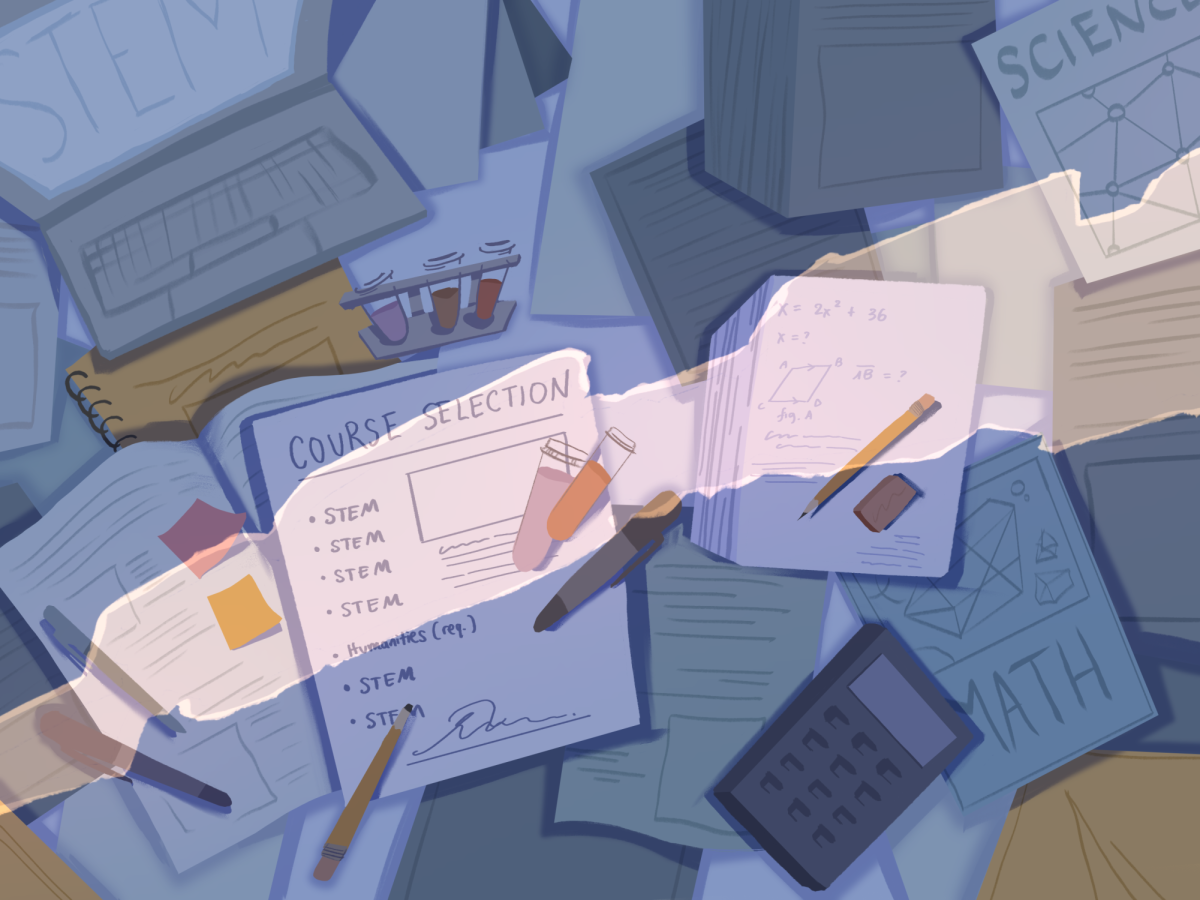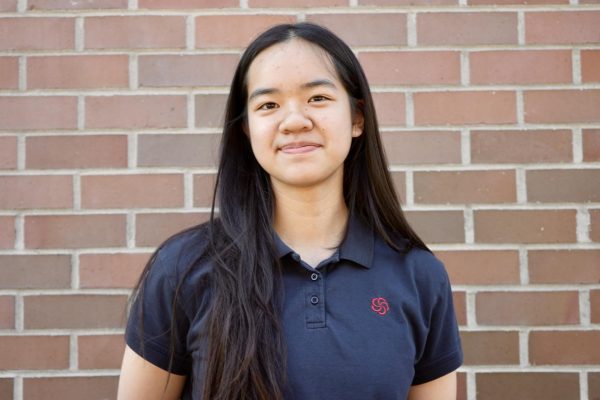POINT, COUNTERPOINT – Zoë
“Is Castilleja becoming a STEM school?” I ask myself as I fill out my course registration for the following school year. But really, what I’m wondering is: is Castilleja no longer focused on the humanities?
When I began filling out my course registration form for freshman year, I was surprised to see the only honors class offered was Algebra II. While a little disappointed, I wasn’t expecting many choices—it was only freshman year after all.
But when April rolled around and I found myself stressing over the same form for sophomore year, I was disheartened to see that the only honors classes were in Chemistry and Geometry. Furthermore, the two new classes offered to Sophomores were AT Java and Engineering I and II.
As a self-proclaimed humanities student, this was incredibly discouraging to me. I went back and forth trying to decide whether or not to take Chemistry and Geometry Honors only to ultimately decide to opt out. I didn’t want to spend even more time on things that didn’t bring me any excitement or satisfaction—and that’s fine; schools should be filled with all types of students who have different interests and passions. But why should the students who happen to be interested in humanities be penalized for that?
When I arrived at my first Geometry and Chemistry classes, I noticed the classes felt smaller than usual. A quick headcount verified: only 11 people in my Chemistry class and 12 in my Geometry class. There is only one period of each non-honors class per subject. For context, there are 54 members of the class of 2026. That means that only about 20% of the sophomore class is in the non-honors Chemistry class, and similarly, only 21% of students are in the non- honors Geometry class.
In recent years, there has been a noticeable trend in high schools nationwide: a shift towards a more STEM-focused (Science, Technology, Engineering, and Mathematics) curriculum. STEM education has gained momentum in recent years, driven by the rapid advancements in technology and the increasing demand for professionals in STEM-related fields.
Home to Silicon Valley (and Castilleja), the Bay Area is a breeding ground for groundbreaking advancements in technology, software development and engineering. The presence of leading tech companies, such as Google, Apple and Meta, has created a high demand for skilled professionals in STEM fields, driving job growth and economic prosperity in the region. As a result, STEM education is considered essential for preparing the next generation of innovators and industry leaders who will continue to drive the region’s success and shape the future of technology and science. These values, coupled with the fact that many parents in the Bay Area work in STEM-related industries or highly value STEM education, creates a mindset where students may feel the need to excel in STEM subjects to succeed in the culture of the Bay.
In 2023, there was a staggering disparity between men and women represented in STEM fields; women make up only 28% of the STEM workforce. As an all-girls high school, Castilleja focuses on female empowerment and instilling the belief that women are just as capable in any career or field as men. This mindset is incredible, and I feel immensely grateful to go to a school that believes so deeply in the capabilities of its students. However, I wonder if Castilleja is moving away from humanities and emphasizing STEM education because of this historical (and current) gender gap. Essentially, are we doubling down on STEM to overcompensate for the centuries in which women were denied opportunities in STEM disciplines because as a progressive all-girls school, we feel obligated to help level the playing field?
As Castilleja continues its push deeper into STEM education, driven by the culture of the Bay Area and the historical gender gaps, I worry that the traditional humanities-based education that has always been the bedrock of liberal arts education is suffering. And this is not just a Castilleja phenomenon—we see this trend occurring on the collegiate level as well. According to the New York Times, in 1970, social sciences were the most popular majors; however, today social sciences make up just 8 percent of college degrees.
Working to eliminate the gender gap and preparing young women for important careers in STEM is an admirable goal and one we should celebrate. That being said, I can’t help but feel the pendulum has swung too far away from humanities. After all, women should be learning and leading in all disciplines, not just STEM.

POINT, COUNTERPOINT – Taarini
When I was in 8th grade, filling out my course requests for freshman year, I noticed something I thought was awfully weird. My English requirement was larger than my math requirement. I mean, sure, English is the foundation of communication in this country, but math was arguably the foundation for everything else. At the time, I didn’t think much about it.
When entering ninth grade, I noticed we were being discouraged from taking honors classes, being repeatedly told that they don’t have to take the classes simply because they want to take hard classes. This is something I’ve noticed the college counselors say in webinars about Course Registration multiple times. While I feel that this is true to some degree, a majority of the honors and AT classes offered that are not required are in STEM subjects. In fact, AT English Senior Seminars and AT US History are the only AT classes required for graduation. These are both Humanities classes. There are no AT STEM courses required for graduation.
This year, I am planning on taking the Geometry Exemption Exam, in order to take Intro to Calculus in my sophomore year. I have been discouraged many, many times in the process of taking this exam. Even the Course Catalog discourages a student from skipping Geometry. “The department does not encourage or recommend pursuing exemption, unless the student has taken and excelled in a rigorous geometry course.” This is an excerpt from the Geometry Exemption Policy document, which can be found in the Course Catalog. Though it also states that exempting oneself does not allow one to take any higher level courses, it certainly opens opportunities for them to. It offers students one more class period to take classes they want to take. For example, when filling out my four year course planner, I noticed I wasn’t able to take all the classes I wanted to if I were to fail the GEE.
As well as being discouraged from taking challenging math courses, this affects the sciences as well. Castilleja states that students need only take geometry and one additional year in order to meet their graduation requirement for math. If a student were to only complete this requirement and then (rather unwisely, I would say) drop math, they would have only completed Intro to Calculus. In many schools, students take Biology in freshman year, and Physics in junior year, as normally, an understanding of Calculus is required to learn Physics. I have a strong belief that Calculus is vital to properly learn and understand Physics. However, since Calculus is not a required course, the course may not cover some fundamental Physics concepts, and cannot go more in depth into others. If Physics were a class taught in junior year, students would have a greater understanding of the concepts, since math is essential to learning it.
STEM courses are also normally portrayed as classes that are harder that others, or as courses that are challenging. Many students have a negative attitude towards math, simply because it may not come easily. With the right mindset and determination, topics in math, though sometimes challenging, can be mastered, changing the attitudes of students that they cannot do math simply because it’s hard. I’ve noticed that students also have a more positive attitude towards humanities subjects, such as English or History, which are normally portrayed as easier subjects.
In the Course Catalog, it states that students need to take English all four years of high school. After some research, I realized that this made sense, since the UC requirement is four years, as well as many colleges across the country. While colleges claim this is to make sure students applying have developed skills in reading and writing, in most colleges, this is much higher than their math requirement. According the UC admissions website, in the UC school system, only 3 years of math are required, only needing completion of a 3-D geometry course.
Throughout the years, subtly, students are straying further and further away from STEM subjects, and closer to Humanities. While their interests may be changing, I believe it is important for every student to have a strong foundation in Science and Math, as to better understand how the world works and to better prepare them for the future, even if they end up going into a mostly unrelated field of study.





